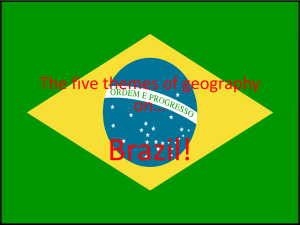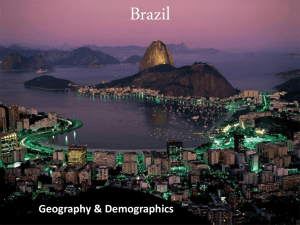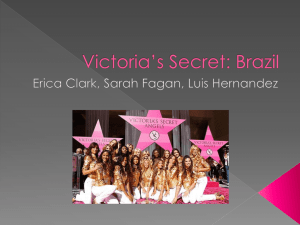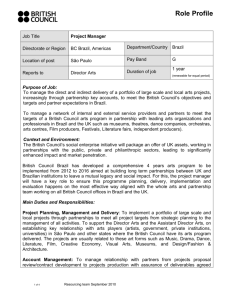Brazil - A Quincentenary Exhibit
advertisement
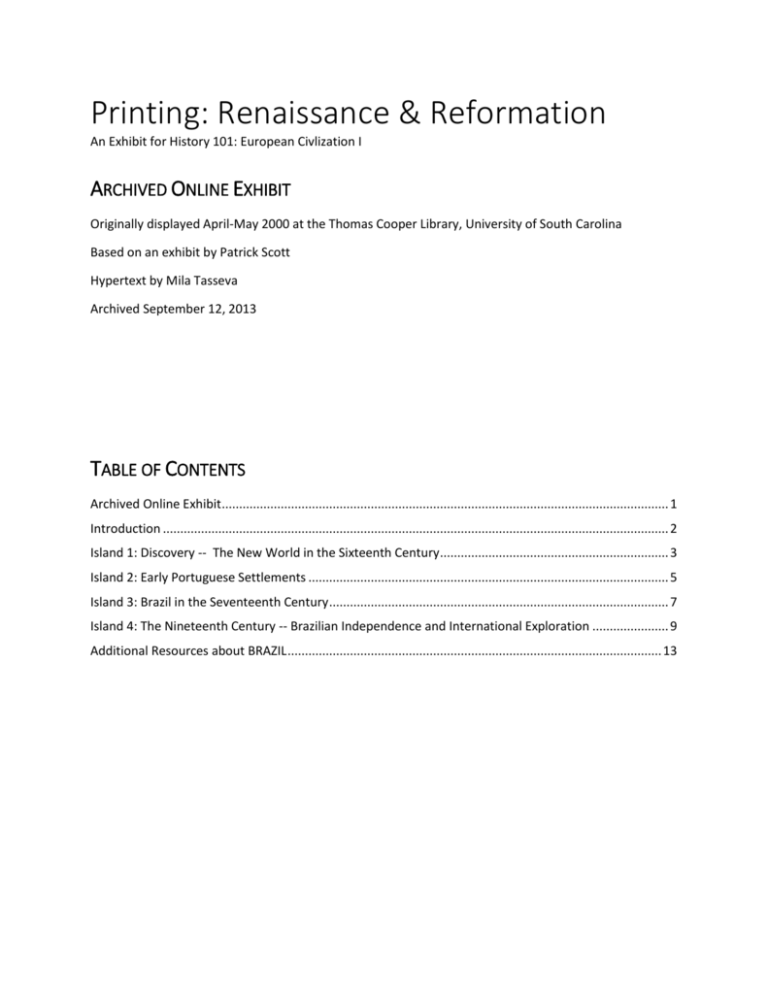
Printing: Renaissance & Reformation An Exhibit for History 101: European Civlization I ARCHIVED ONLINE EXHIBIT Originally displayed April-May 2000 at the Thomas Cooper Library, University of South Carolina Based on an exhibit by Patrick Scott Hypertext by Mila Tasseva Archived September 12, 2013 TABLE OF CONTENTS Archived Online Exhibit ................................................................................................................................. 1 Introduction .................................................................................................................................................. 2 Island 1: Discovery -- The New World in the Sixteenth Century .................................................................. 3 Island 2: Early Portuguese Settlements ........................................................................................................ 5 Island 3: Brazil in the Seventeenth Century .................................................................................................. 7 Island 4: The Nineteenth Century -- Brazilian Independence and International Exploration ...................... 9 Additional Resources about BRAZIL ............................................................................................................ 13 INTRODUCTION In April 2000 Brazil celebrated the five hundredth year since the first Portuguese landed on the coast of South America. Brazil would become not only the largest Portuguese-speaking nation in the world, but among the largest countries of any language and continent. Brazilian history is not an area in which the library has deliberately or recently built up rare collections. It is a tribute to the historical importance and quality of the original South Carolina College library, and to the generosity of more recent donors, that such an exhibition can be mounted for the Thomas Cooper Library special collections, and that it includes so many significant and beautiful items. ISLAND 1: DISCOVERY -THE NEW WORLD IN THE SIXTEENTH CENTURY The first Portuguese landfall on the Brazilian coast, April 24th, 1500 from Samuel Purchas, 1577?-1626. Pvrchas his Pilgrimage. Or Relations of the world and the religions obserued in all ages and places discouered, from the creation vnto this present. Contayning a theologicall and geographicall historie of Asia, Africa, and America, with the ilands adiacent. 4th edition. London, Printed by William Stansby for Henry Fetherstone, 1626. The first European knowledge of Brazil was a voyage down part of the coast, early in 1499, by a Spanish vessel under Vincente Yanez Pinzon. Early the next year, a Portuguese flotilla, under Pedro Alvares Cabral, were driven off course to the Brazilian coast, reaching Porte Seguro on Good Friday, claiming the country for Portugal and naming it Terra del Verra Cruz, the land of the true cross. The name Brazil, which very soon replaced Cabral's name, comes from the brasilia dye-wood that the early explorers took back to Europe. This was the volume (originally published in 1613) was the first of Purchas's several influential compilation of exploration-narratives, though it is bound as volume 5 of the South Carolina College library set. A narrative of the first Portuguese arrival in Brazil, 1500 Robert Southey, 1774-1843. History of Brazil. 3 vols. London: Longman, Hurst, Rees, Orme, and Brown, 1817-22. Rebound. It may seem strange that the best-known English-language history of early Brazil was written by the British poet laureate, Robert Southey. In fact Southey had visited Portugal as early as 1795 and in the early 1800s made a significant income from Portuguese and Spanish translation work. During the Napoleonic Wars, Britain was an ally of the Portuguese government in exile, and after the war it became also a strong supporter of Brazilian independence. Southey's Brazil includes a history of the entire region between the La Plata and the Amazon rivers, to the year 1808, and after Brazilian independence in 1822 was continued by John Armitage for a further two volumes (see case 7, lobby). The world and the New World in 1513 Martin Waldseemuller, 1475-?1522, from Claudius Ptolemaeus Alexandrinus, fl. 2nd century; Michael Servetus, ed. Geographicae e Narrationis. Libri Octo. Lyons: Melchior and Gaspar Trechsel, 1535. This beautiful French-printed folio edition of Ptolemy's atlas reflects the image of the world as known from classical times till the sea-voyages of the late fifteenth-century. The 1535 Trechsel printing used woodblocks that had been recut by Laurentius Frisius in 1522 from Waldseemuller's edition, originally published in Strasbourg in 1513. It was Frisius who first added the legends crediting Columbus with his discoveries in the Americas. Note also the many saints' names already given by the Portuguese to features or settlements on the Brazilian coast. The Americas in the late 16th century Theodor Johann de Bry, c. 1527-1598, Historiae Novi Orbis [America or Greater Voyages] 2 vols. Frankfurt: Wolfgang Richter, 1590-1630. Original vellum. The Frankfurt engraver Theodor de Bry issued two major series of exploration narratives, the Greater Voyages about American exploration, the Lesser Voyages covering Africa and Asia, both with fine illustrations and beautiful, now very rare, maps. The fold-out map of the New World shown here was published by de Bry in 1596. The antebellum South Carolina College purchased this set of de Bry's Greater Voyages for $55, in the 1820s. ISLAND 2: EARLY PORTUGUESE SETTLEMENTS The Portuguese settlement in Brazil, at the Island of St. Vincent Hans Staden, 1525-ca. 1576., Americœ tertia pars memorabile provinciœ Brasiliœ historiam contines, germanico primùm sermone scriptam à Ioane Stadio, nunc autem latinitate donatam à Teucrio Ann'o Privato Colchanthe. in Theodor Johann de Bry, Historiae novi orbis, pars 3, cap. 3. Frankfurt: Wolfgang Richter, 1593. Original vellum. DeBry's original inspiration for his Voyages had been the drawings by the Englishman John White illustrating Harriot's account of Raleigh's voyage to Virginia (London 1588), and his collection was augmented by numerous engravings of the Europeans settlements in the Americas, as well as of Indian life and customs (as here in the out-of-scale depiction of canoes alongside the Portuguese caravels). An early Portuguese description of Brazil from Samuel Purchas, 1577?-1626. Hakluytus Posthumus or Purchas his Pilgrimes . . .Volume IV. First edition. 4 vols. London: printed by W. Stansby for H. Fetherstone, 1625. Later sprinkled calf. Samuel Purchas, a Cambridge-educated clergyman who was Rector of St. Martin's Ludgate, London, from 1614-1626, published in all six volumes that became of one the major sources through which the Renaissance sea-discoveries were known to English readers. This culminating 4-volume work is based on contemporary manuscript accounts collected by his predecessor Thomas Hakluyt (1552-1615), but not included in the latter's similar compilations. An early seventeenth century map of South America Engraving after Jodocus Hondius, 1563-1611, from Samuel Purchas, 1577?-1626. Hakluytus Posthumus or Purchas his Pilgrimes . . .Volume III. First edition. 4 vols. London, Printed by W. Stansby for H. Fetherstone, 1625. Later sprinkled calf. Hondius, a Flemish-born engraver who settled in England in 1584, was one of the most prolific mappublishers of his period, though most of his maps were borrowed or closely based on those of other cartographers. This map shows clearly the pattern of Portuguese exploration along the Brazilian coast, with several early settlements named for the saints' days when they had been reached. Hondius's map also shows the east-west distortion common in maps of the Americas before the invention of an accurate chronometer and the solution of the longtitude problem in the mid-18th century. Catholicism in early Brazil PŠre Claude d'Abbeville, d. 1632. Histoire de la mission des pères capucins en l'isle de Maragnan et terres circoncoisines, où est traicté des singularitez admirables et des moeurs merveilleuses des Indièns habitans de ce pays, avec les missives et advis qui ont esté envoyez de nouveau. Paris: F. Huby, 1614. Later green morocco, tooled in gold and blind. Portuguese settlement in Brazil is closely bound up with Catholicism. Two days after the first landfall, on Easter Sunday 1500, Cabral's men set up a large cross and improvised altar for the celebration of an open-air Mass. This French account of missionary work among Brazilian Indians on Maranhão island stands therefore for one of the major effects of Portuguese colonization, though it also (as in the passage shown here) shows a sharp eye for aspects of Brazil's natural history that would seem exotic to European readers. ISLAND 3: BRAZIL IN THE SEVENTEENTH CENTURY Brazil in the early seventeenth century Joannis de Laet, 1583-1649. "Provincia de Brasil," from his Novus orbis, seu Descriptionis Indiae Occidentalis. . . . Novis tabulis geographicis et variis animantium, plantarum fructuumque iconibus illustrati. Leiden: Elzevir, 1633. De Laet's small folio about America was first published with a Dutch text in 1625 and again in 1630, republished with this Latin text in 1633, and then again in French in 1640. De Laet's maps were produced with the help of Hessel Gerritz, a former apprentice of W. J. Blaeu (see next item). This specially-bound copy of the Latin version is stamped with the arms of Cardinal Richelieu. Picturing seventeenth-century Brazil, I Willem Janssoon Blaeu, 1571-1638, "Paraiba et Rio Grande," from Joan Blaeu, 1596-1673, comp., Le grand atlas, ou, Cosmographie blaeviane: en laquelle est exactement descritte la terre, la mer et le ciel; v.12. Amerique. Amsterdam: Chez Jean Blaeu, 1667. Kendall Collection. Pariaba, in northeast Brazil, was first settled in 1584, as a centre for sugar-cane production. The twelve volumes of maps in this collection, the Grand Atlas, published by Blaeu's son in various editions with accompanying text in different major languages, cover the whole known world and constitute the single most important Renaissance map series in Thomas Cooper Library. The beautiful hand-colored copperplates of the Blaeu atlas are nearly all reprintings of maps originally engraved and issued by the elder Baeu in the 1630s and 1640s. Further Blaeu maps of Brazil include a general map of the whole country; San Salvador and Bahaia de Todos Santos;Sergipe del Rei; Pernambuco (north), and Pernambuco(south). Picturing seventeenth-century Brazil, II Arnoldus Montanus, fl. 1670, "Olinda de Phernambuco," from his De Nieuwe en onbekende weereld: of Beschryving van America en 't zuid-land, vervaetende d'oorsprong der Americaenen en zuid-landers, gedenkwaerdige togten derwaerds, gelegendheid der vaste kusten, eilanden, steden, sterkten, dorpen, tempels, bergen, fonteinen, stroomen, huisen, de natuur van beesten, boomen, planten en vreemde gewasschen, Godsdienst en zeden, wonderlijke voorvallen, vereeuwde en nieuwe oorloogen: verciert met af-beeldsels na 't leven in America gemaekt. Amsterdam: Jacob van Meurs, 1670-71. Alfred Chapin Rogers Collection. Little is known about Montanus, but it is interesting that the Brazilian state depicted here, Pernambucio on the northeast Atlantic coast, though settled bu the Portuguese as early as 1524, had been occupied by his Dutch fellow-countrymen from 1630-1654. Later, in 1817, just before Brazilian independence, Pernambuco would be the centre of an uprising against Portuguese rule. Picturing seventeenth-century Brazil, III John Ogilby, 1600-1676. "Sinus Omnium Sanctorum [The Bay of All Saints]," from his America: being the latest, and most accurate description of the New World; containing the original of the inhabitants,and the remarkable voyages thither. London: Printed by the author, 1671. Large paper copy, from the Kendall Collection. The city of Bahia or Sao Salvador, on Bahia de todos sanctos (the Bay of All Saints) south along the Atlantic coast from Pernambuco, was founded by the Portuguese in 1549. Ogilby'sAmerica, both text and plates, was largely plagiarized from the work of Montanus the year before (see previous item), thus allowing display of a further Brazilian engraving of the period. Note: the best-known Ogilby engraving, Moxon's "Lords Proprietors' Map" of South Carolina, added the following year, with no equivalent in Montanus, is displayed on the wall to the far right, in connection with the showing of a recent (nonBrazilian) donation. ISLAND 4: THE NINETEENTH CENTURY -- BRAZILIAN INDEPENDENCE AND INTERNATIONAL EXPLORATION The coming of Brazilian independence John Armitage, 1807-1865. The history of Brazil, from the period of the arrival of the Braganza family in 1808, to the abdication of Don Pedro the First in 1831. Comp. from state documents and other original sources. Forming a continuation to Southey's history of that country. 2 vols. London: Smith, Elder and co., 1836. During the Napoleonic wars, Brazil had been the seat of the Portuguese monarchy-inexile, and following the defeat of Napoleon in 1815, the two countries were proclaimed coequal as a United Kingdom. This transitional phase ended, after the king returned to Portugal itself, and Brazil assumed its independence in 1822, under the former regent, Dom Pedro. The accompanying picture is talen from a centenary commemoration issued by the Brazilian newspaper Journal de Commercio, loaned for this exhibit by Prof. Maria Angelica Lopez. A map of Brazil in the 19th century from Daniel P. Kidder, 1815-1891. Brazil and the Brazilians portrayed in historical and descriptive sketches. Philadelphia, Childs & Peterson; New York, Sheldon, Blakeman & Co., 1857. This fold-out map, detached from its original volume in rebinding, shows the huge expanse and vast natural resources that drew nineteenth-century explorers and settlers to Brazil and made possible both its independence and its economic development. Mawe, John, 1764-1829. Travels in the interior of Brazil, particularly in the gold and diamond districts of that country, by authority of the prince regent of Portugal; including a voyage to the Rio de la Plata, and an historical sketch of the revolution of Buenos Ayres. Illustrated with five engravings. Philadelphia: M. Carey, and Wells and Lilly, Boston. 1816. The rich mineral resources of Brazil had attracted interest from the seventeenth-century, but Mawe's book indicates the increased importance they held for Europe with the industrial and technological development of the early nineteenth-century. Koster, Henry, 1793-ca. 1820. Travels in Brazil: . . . In the years from 1809, to 1815. 2 vols. Philadelphia: M. Carey & son, 1817. Contemporary tree calf. Thomas Cooper Library has a second copy of this important source, in original boards, from the collection of the Georgetown Library Society, indicating the links between Brazil and the Southern United States in the early 19th century. The 19th century lure of the Amazon and uncolonized Brazil Herndon, William Lewis, 1813-1857. Exploration of the valley of the Amazon, made under direction of the Navy Department. 2 vols. Washington: R. Armstrong [etc.] Public Printer, 1853-54. Given by Buddy Atkins in memory of Walter Furman Mobley. As this frontispiece illustrates, the vast hinterland of Brazil's Amazon basin attracted the interest of other major powers, under the guise of scientific, geographical and anthropological exploration. The scientific traveler in early 19th century Brazil Humboldt, Alexander von, 1769-1859. Personal narrative of travels to the equinoctial regions of the New continent, during the years 1799-1804. Written in French . . ., and translated into English by Helen Maria Williams. Philadelphia: M. Carey, 1815. The Personal Narrative of the German explorer and scientist Alexander von Humboldt provided one of the most important models for Darwin in keeping his own scientific journal from the voyage of the Beagle to Brazil and South America in the 1830s. Rio de Janeiro in the mid-nineteenth century Daniel P. Kidder, 1815-1891. Brazil and the Brazilians portrayed in historical and descriptive sketches. Illustrated by one hundred and fifty engravings. Philadelphia, Childs & Peterson; New York, Sheldon, Blakeman & Co., 1857. Rio, properly Sao Sebastiao do Rio de Janeiro, was one of the first Portuguese settlements in the early sixteenth century, and capital of one of the original ten "captaincies" into which Brazil was divided in the Portuguese administrative reorganization of 1642. During the Napoleonic wars, it served as the seat of the Portuguese government-in-exile, and it was capital of the Republic of Brazil until 1960. Charles Darwin visits Rio de Janeiro, May 1832 Darwin, Charles, 1809-1882 The journal of a voyage in H.M.S. Beagle. Facsimile of the original manuscript held at Down House, Kent. Guildford: Genesis, 1979. One of 500 copies. C. Warren Irvin Collection. Shown with Darwin, Charles, 1809-1882 Journal of researches into the geology and natural history of the various countries visited by H. M. S. Beagle, under the command of Captain FitzRoy, R. N., from 1832 to 1836. First edition. London: H. Colburn, 1839. Original brown cloth. C. Warren Irvin Collection. After study at Edinburgh and Cambridge, Darwin was appointed naturalist' on the small naval survey ship H.M.S. Beagle. Darwin was already interested in many aspects of natural history (notably botany, entomology, and geology), and he was overwhelmed by the abundance of new species and varieties he found in South America. It was from this voyage that he began to work out his theory of the differentiation of natural species, that he would develop in his Origin of Species(1859). One of the new species that Darwin sent home to Britain "Musa Brasiliensis," from Charles Darwin, ed., he Zoology of the voyage of H.M.S. Beagle, under the command of Captain Fitzroy, R.N., during the years 1832 to 1836. Published with the approval of the Lords Commissioners of Her Majesty's Treasury. Pt. II. Mammalia, described by George R. Waterhouse, Esq. . . . ; with a notice of their habits and ranges, by Charles Darwin, Esq. London: Smith, Elder, 1839. Contemporary calf. Stamp of South Carolina College on upper cover. Darwin sent or brought back to Britain thousands of new species from the Beagle voyage, and arranged for the leading naturalists in each field to describe them for this lavishly illustrated official report, published in parts over a four-year period. Waterhouse's report on the new mammal specimens was the first section to appear. Nineteenth century European exploration Adalbert, Prinz von Preussen, 1811-1873. Travels of His Royal Highness Prince Adalbert of Prussia, in the south of Europe and in Brazil, with a voyage up the Amazon and the Xingú. Translated by Sir Robert H. Schomburgk and John Edward Taylor. 2 vols. London: D. Bogue, 1849. A 19th-century Brazilian country estate from Johann Baptist von Spix, 1781-1826. Travels in Brazil, in the years 1817-1820: undertaken by command of His Majesty the King of Bavaria. Translated by H.E. Lloyd. 2 vols. London: Longman, Hurst, Rees, Orme, Brown, and Green, 1824. ADDITIONAL RESOURCES ABOUT BRAZIL The historical materials and rare items in this web-exhibit can be supplemented by a wide variety of online resources about modern Brazil. o Resources about Brazil from the University of Michigan o Resources about Brazil from the University of Texas o Resources about Brazil from the Library of Congress Books about Brazil in the University of South Carolina libraries may be identified through the online catalog.



